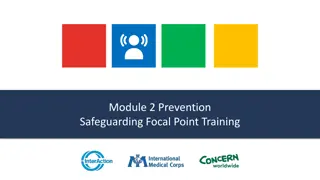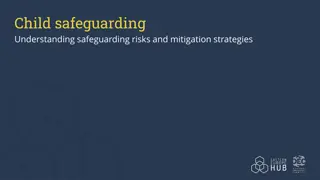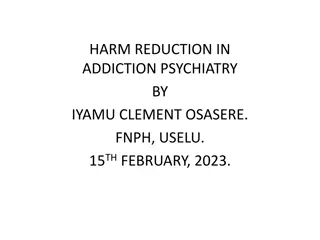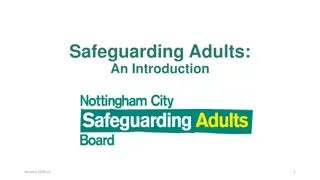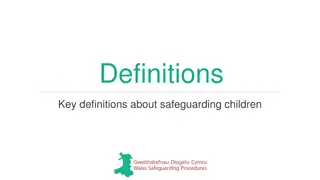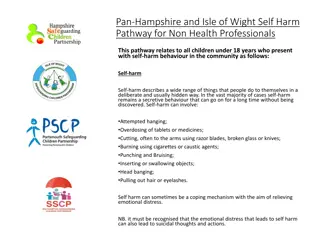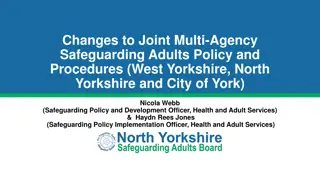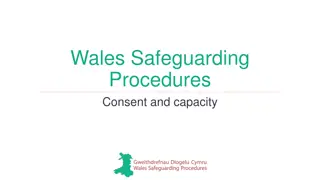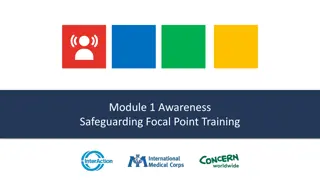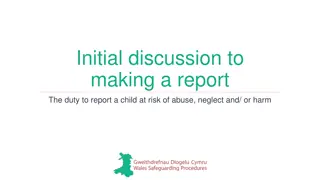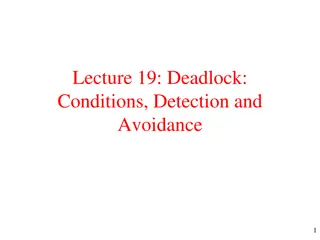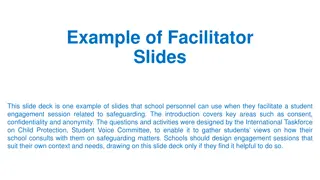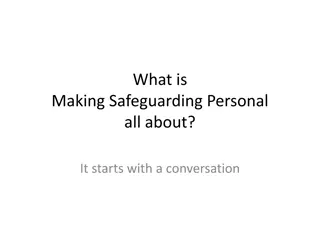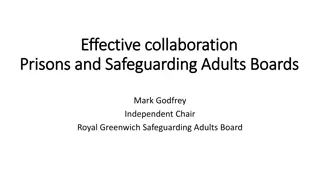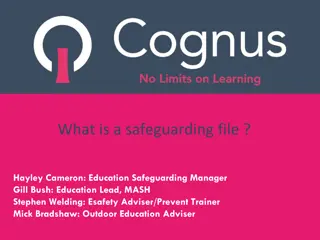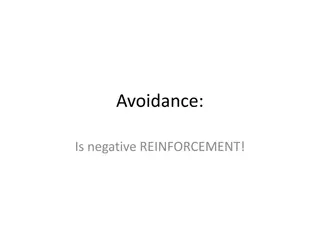
Safeguarding: Why, What, and How to Ensure Harm Avoidance
Safeguarding is crucial to prevent harm, particularly in addressing Sexual Exploitation, Abuse, and Harassment (SEAH) in the aid sector. Learn about its meaning, objectives, and how it affects at-risk groups like girls and women.
Download Presentation

Please find below an Image/Link to download the presentation.
The content on the website is provided AS IS for your information and personal use only. It may not be sold, licensed, or shared on other websites without obtaining consent from the author. If you encounter any issues during the download, it is possible that the publisher has removed the file from their server.
You are allowed to download the files provided on this website for personal or commercial use, subject to the condition that they are used lawfully. All files are the property of their respective owners.
The content on the website is provided AS IS for your information and personal use only. It may not be sold, licensed, or shared on other websites without obtaining consent from the author.
E N D
Presentation Transcript
OFFICIAL Safeguarding Why, what and how - to make sure we do no harm The British Embassy Karuna Onta, Social Development Advisor Nov 20, 2020
OFFICIAL How big is the problem? #AidToo 2
OFFICIAL What does Safeguarding mean? Safeguarding broadly means avoiding harm to people or the environment, but UKaid is focusing on tackling Sexual Exploitation, Abuse and Sexual Harassment( SEAH ) in the aid sector both in our organization and with partners we fund. PREVENT it from happening LISTEN to those who are affected RESPOND sensitively but robustly LEARN from every case 3
OFFICIAL What is sexual exploitation, abuse and harassment (SEAH)? Sexual Exploitation means: any actual or attempted abuse of a position of vulnerability, differential power, or trust for sexual purposes. Includes profiting momentarily, socially, or politically from sexual exploitation of another. Under UN regulations it includes transactional sex, solicitation of transactional sex and exploitative relationship. Sexual Abuse means: the actual or threatened physical intrusion of a sexual nature, whether by force or under unequal or coercive conditions. It shouldcover sexual assault (attempted rape, kissing / touching, forcing someone to perform oral sex / touching) as well as rape. Under UN regulations, all sexual activity with someone under the age of 18 is considered to be sexual abuse. Sexual Harassment means: unwelcome sexual advances (without touching). It includes requests for sexual favours, or other verbal or physical behaviour of a sexual nature, which may create a hostile or offensive environment.
OFFICIAL SEAH - Most at Risk Groups Girls, especially adolescent girls Women Boys Displaced People who are already experiencing discrimination Lesbian, gay, bi and transsexual (LGBTQ+) people People with disabilities Women working on frontline service delivery
OFFICIAL What are UKaid objectives? to improve safeguarding standards across the aid sector, holding ourselves to at least the same high standards we expect of our partners. to tackle power imbalances, particularly gender inequality; taking a survivor-centred approach; and encouraging reporting while doing no harm. New capacity Safeguarding Unit (SGU) is leading on sector change; HR leads on updates to internal policies and procedures; Internal Audit s new Safeguarding Investigations Team leads on case management; BDD leads on due diligence 6
OFFICIAL What is covered by Enhanced Due Diligence A summary overview of the six areas in the new safeguarding due diligence HR Risk Code of Conduct Whistleblowing Governance Safeguarding Management Policy Code of conduct Job description and risks Policy Designated Safeguarding Officer Policy Downstream partners Training Training Prioritise people Selection and Interview Complaints process Safeguarding Register Categories Reporting to Board Sign & evidence References and vetting Risk register Zero reprisals Investigation process Training Annual report Risk owner Ethics & behaviour Senior oversight Disciplinary process Downstream Partners
OFFICIAL What we need to do? Improving our REPORTING rate Improving our RESPONSE SUPPORTING victims / survivors Changing our CULTURE Strengthening the EVIDENCE base This is something WE ALL NEED TO TACKLE
OFFICIAL What are the Nepal specific safeguarding issues that we need to include in the guidance? 1. Caste, child labour, child marriage, chaupadi, 2. Adult entertainment sector and treatment of sex workers 3. UK vs. Nepal Cultural norms, 4. Labour laws vs. practice weak to non existent 5. Nepal s laws and their interpretation vs. UK 6. Patronage and extortion and social pressure not too report 7. Not safe to report as limited protections 8. Lack of credible references
OFFICIAL What are the practical barriers to ensuring safeguards are being followed by? Inconsistent policies and unclear polices Fear of reporting to UKaid Low recognition of issues by partners Acceptance of some behaviours as normal No way of checking past of employees Costs of checking and how to do properly Delays to implementation
OFFICIAL Initial Partners Feedback Risk are known but lack tools to mitigate Hard to get reliable background checks Policies ok, but ensuring they are followed is hard We lack case studies to learn from and test systems against Remote areas very difficult to supervise Culture of acceptance in some areas Reporting not reinforced and discouraged Need complaint hotline/system in Nepal which can act and protect Need to understand and document the perspective of survivors and what would have helped them Make reporting easy, protected and business as usual Challenge acceptance of normalised behaviours Need to set clear standards so we know what is internal, shared with UKaid and reported to police
OFFICIAL Summary of Mandatory Safeguarding Partner Standards - Safeguarding: - The partner has an overarching Safeguarding Policy or specific policies for Sexual Exploitation, Abuse and Sexual harassment, child labour & exploitation and are able to mitigate issues arising from accepted cultural and social norms. E.g. Chaupadi & child labour. If the organisation works with children of vulnerable adults or young people they must have a child protection policy and/or vulnerable adults policy. o A good safeguarding policy will include information around: policy; training; safeguarding register; investigation process; disciplinary process; capacity building and managing risks with downstream partners Policy required to pass Due Diligence Assessment Whistle-blowing: - The partner has a policy, likely to be called Whistle-blowing or Complaints/Concerns policy or may be within the Safeguarding policy - A good complaints/ whistle-blowing policy will include: a clear process to follow if the complaint / concern is raised; assigns an individual to manage internal complaints and concerns; sets out that there can be no reprisals for the whistle blower; includes information on staff training Policy required to pass Due Diligence Assessment Human Resources: - If a role is to work with children and or vulnerable adults the interview process will assess SEAH competencies. - For all other roles that do not work directly with children, young people and vulnerable adults there should be mandatory safeguarding and whistleblowing training as part of the induction. - For all staff there should be regular refresher training on safeguarding and whistleblowing. o A good HR approach to safeguarding will include evidence of PSEAH in: Job descriptions and risks; selection and interview; and in references and vetting Risk Management: - Organisational level: The partner has a risk management framework that includes SEAH and Nepal specific safeguarding issues listed below. - Project level: The partner routinely uses risk registers at the project level that consider SG issues - If the organisation is working with vulnerable people, SEAH should be a separate risk category within the risk frameworks o A good Risk Management approach will include: a policy statement; use of risk registers; clarity for escalation of safeguarding risks; senior level oversight; and the expectations of risk management for downstream partners should be made explicit in the risk policy or approach. Code of Conduct: - The Partner has a Code of Conduct for all staff that clarifies the values, principles and the acceptable behaviours. This should include explicit reference to preventing SG issues, and in particular SEAH. o A good Code of Conduct will: describe the ethics and behaviours required of all parties; prioritise people; reflect senior level commitment to SEAH. Governance and Accountability: The organisational Board (trustees appointed or elected or shareholders) has ultimate responsibility for safeguarding and should always act in the best interests of the beneficiaries, staff and volunteers. - It is vital that the board is independent in its safeguarding decision making. It should not be unduly influenced by those who may have special interests. o A good Governance structure will include: a designated safeguarding officer at Board level; evidence of regular reporting to the senior leaders and Board [1]For child safeguarding issues, measuring partner s standards against the Keeping Children Safe standard. Link available here.
OFFICIAL TIPS to ensure SG mechanisms Question: 1.Field staff awareness of Safeguarding policy To what extent are all staff aware of the organisation s safeguarding policy? How often is the policy reviewed? Further guidance This should also include downstream partners and beneficiaries. There should be a clear SG mechanism in place to conduct a rigorous assessment of the disclosure as well as clear disciplinary procedures to follow if necessary. The SG officer should report regularly to senior leadership. The partner could have a SG hotline in place as best practice. 2.Identification of safeguarding risks How are safeguarding risks identified in the programme? 3.Organisation safeguarding representative Is there a designated senior safeguarding officer or champion? Are they known to everyone? What is their role? The partner should have a policy called whistleblowing or reporting. This should include a clear process to follow and a designated SG point of contact. 4.Reporting mechanisms Is there a designated process in place for reporting safeguarding issues / concerns? Do you provide mandatory training for all staff on the whistle blowing procedures? Reporting should beconfidential and there should be no reprisals for the whistle blower. All staff should have training. Does the partner have procedures in place if the following is uncovered: 1.Child marriage 2.Chaupadi 3.Child labour 4.Caste discrimination 5.Gender related discrimination If any incidents become apparent during field visit, these should be logged and flagged with the head of office or authorities - on return or immediately depending on severity. The partners response to SG issue should be monitored. The HR department should carry out extensive verification process of candidates including criminal background checks. There should be mandatory safeguarding and whistle blowing training in place during induction processes. See.3 As well as recognised vetting, the candidate should have 3 references from previous employers / other who have knowledge of their suitability to work with children. The organisations board has ultimate responsibility for safeguarding of all partners and beneficiaries and its their duty to ensure these parties are aware of the code of conduct. Are there capacity building mechanisms in place for the downstream partners? Partners should have detailed register of previous SG issues. Programmes should use delivery plans and quarter/annual reports to monitor risks and any lessons should be fed into future programme design to mitigate future SG issues. What protections are in place for those who report concerns? 5.Caste, gender & child issues [Nepal specific] What mitigations are in place to ensure cultural and social pressures especially related to caste, gender or children do not create SG risks for the programme? 6.Actual incidents Have there been any past safeguarding issues associated with the programme? Are there any currently under investigation? 7.Recruitment process and prior employment checks What background / prior employment checks are in place during the recruitment process? [If programme is child related] What vetting process is used? Have you had any difficulty in attaining past information about potential employees? 8.Downstream partners & beneficiaries Are partners aware of the safeguarding policy? Has there been a risk assessment undertaken of lower level partners? Are beneficiaries aware of safeguarding expectations? 9.Lessons learning [If previous SG cases] Have you undertaken a review of previous SG cases? What have you changed as a result?
OFFICIAL We do not have all the answers We need your help in ensuring we do no harm So time to get your views on these questions: i) Major safeguarding issues ii) Barriers to effective safeguarding iii)How to make it safe to report and take action iv)What are the good practices

